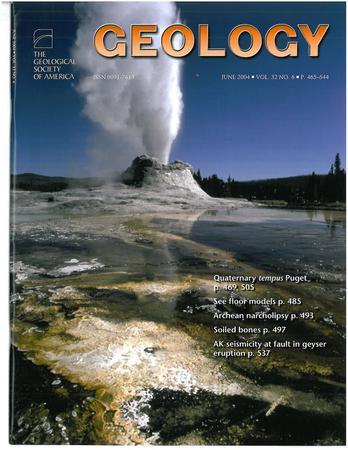Kilometers-scale subsidence of the inner Puerto Rico Trench wall since the Pleistocene
IF 4.6
1区 地球科学
Q1 GEOLOGY
引用次数: 0
Abstract
We have observed a thin veneer of Pleistocene-age carbonate rocks on the southern side of Mona Block, a seamount northwest of Puerto Rico, above a water depth of 1800 m. Mona Block is located within the inner wall of the Puerto Rico Trench. A similar veneer of carbonate rocks (corals and pavement) was encountered during a deep submergence vehicle (DSV) Alvin dive in 1976 on the north side of Mona Block at depths of 3650−2900 m. We also observed a remnant Oligocene−Pliocene carbonate platform at a depth of 2080 m on the east side of the block. Restoring the carbonate outcrops to near sea level implies that Mona Block, with a summit currently at 670 m bsl, was an island with an elevation of ≥1000 m until the mid-Pleistocene and has subsided and tilted to the north thereafter. We suggest that the observed subsidence was caused by the foundering or retreating North American slab, which gave rise to the anomalously deep Puerto Rico Trench. Our estimated trench wall subsidence varies nonlinearly from ∼800 m in the distal part to ≥3700 m near the trench. Carbonate platform subsidence north of Puerto Rico is older (mid-Pliocene), suggesting that subsidence and, by inference, trench collapse had propagated westward with time. Mona Block is thus a yardstick for studying mantle processes associated with slab retreat and foundering.自更新世以来波多黎各海沟内壁的千米级下沉
我们在波多黎各西北的海山莫纳地块的南侧观察到一层薄薄的更新世碳酸盐岩,水深1800米以上。莫纳街区位于波多黎各海沟的内壁内。1976年,深海潜水器(DSV) Alvin在莫纳地块北侧3650 - 2900米的深度潜水时,发现了类似的碳酸盐岩饰面(珊瑚和路面)。在地块东侧2080 m深度处发现渐新世—上新世碳酸盐岩台地遗迹。将碳酸盐岩露头恢复到接近海平面的位置,表明莫纳地块在更新世中期以前是一个海拔≥1000米的岛屿,目前最高点为670米bsl,此后逐渐下沉并向北倾斜。我们认为观测到的下沉是由北美板块的沉降或后退引起的,这导致了异常深的波多黎各海沟。我们估计的海沟壁沉降从远端~ 800米到海沟附近≥3700米呈非线性变化。波多黎各北部的碳酸盐台地沉降较早(上新世中期),表明沉降和由此推断的海沟塌陷已随时间向西扩展。因此,莫纳地块是研究与板块后退和沉陷相关的地幔过程的标尺。
本文章由计算机程序翻译,如有差异,请以英文原文为准。
求助全文
约1分钟内获得全文
求助全文
来源期刊

Geology
地学-地质学
CiteScore
10.00
自引率
3.40%
发文量
228
审稿时长
6.2 months
期刊介绍:
Published since 1973, Geology features rapid publication of about 23 refereed short (four-page) papers each month. Articles cover all earth-science disciplines and include new investigations and provocative topics. Professional geologists and university-level students in the earth sciences use this widely read journal to keep up with scientific research trends. The online forum section facilitates author-reader dialog. Includes color and occasional large-format illustrations on oversized loose inserts.
 求助内容:
求助内容: 应助结果提醒方式:
应助结果提醒方式:


